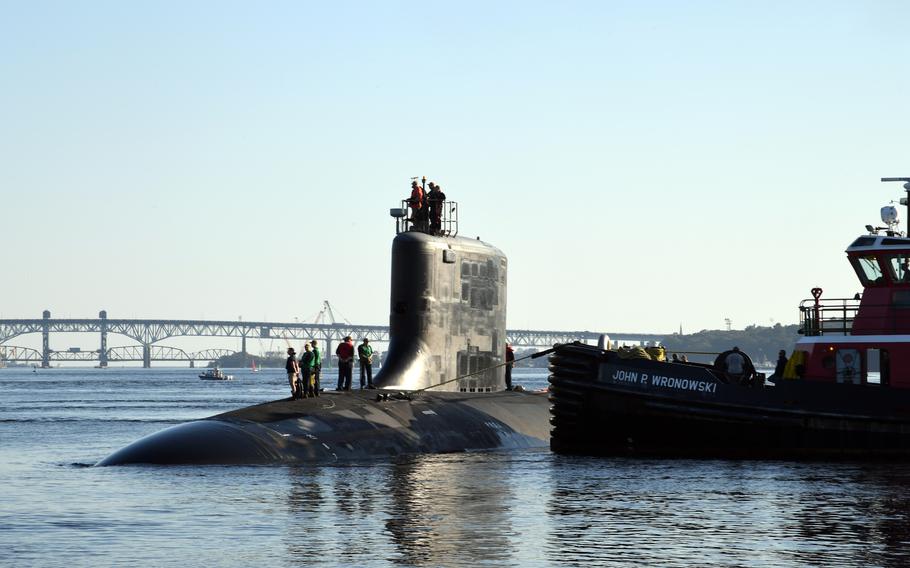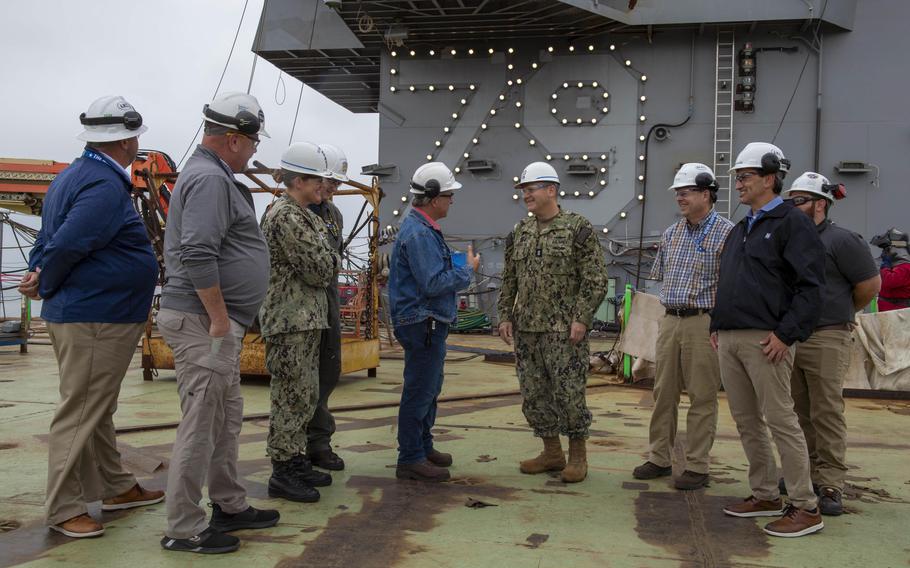
The future USS Hyman G. Rickover transits the Thames River on its way to Naval Submarine Base New London in Groton, Conn., on Oct. 3, 2023. A rise in the cost of submarines is one reason the Navy will need a bigger budget than it has estimated in order to achieve its long-term goals, according to a recent Congressional Budget Office report. (Joshua Karsten/U.S. Navy)
The Navy’s plan to create a larger, more lethal fleet will cost billions of dollars more than the service says while reducing its firepower in the short term, an analysis by the Congressional Budget Office found.
The service plans to retire more destroyers, cruisers and submarines than it will commission over the next 10 years, according to a CBO report released Thursday. The CBO analyzed the service’s 2024 30-year shipbuilding plan submitted to Congress in March.
If the Navy sticks to its schedule for retiring ships, the fleet will reach a low of 285 ships by 2026 and 2027 before increasing in size. Overall, the fleet would be smaller than it is now for the next decade, the CBO said.
The fleet’s lethality, “as measured in part by the total number of missile cells, would decline by 12% until 2032,” the CBO said in the report. The trend would then reverse, and the fleet would have about 20% more vertical launch system cells in 2053 than it does now, the CBO report noted.
Costs for the Navy’s plan to acquire a fleet of the future — buying as many as 340 ships — would average $34 billion to $36 billion annually for the next 30 years. That’s 16% more than the service estimates, the CBO said.
Purchasing, operating and maintaining that fleet would require the Navy’s annual budget to increase about 30%, from “about $245 billion today to between $315 billion and $330 billion (in 2023 dollars) in 2053,” the CBO said.
The Navy’s 2024 shipbuilding plan includes three long-term alternatives to grow the fleet and its capabilities over the next 30 years. Like the 2023 plan, it continues a pivot from large surface vessels to smaller, more nimble combat ships to ultimately increase the fleet to as many as 367 ships.

Rear Adm. Tom Anderson, acting commander of Naval Sea Systems Command, discusses the construction status of the aircraft carrier John F. Kennedy on Sept. 28, 2023, at Newport News, Va. To achieve its 30-year shipbuilding goal, the Navy will need a bigger budget than the service expects, according to a recent Congressional Budget Office report. (Tyler Slavicek/U.S. Navy)
Under the first alternative, the Navy would buy 290 ships, adding 38 more small surface and medium landing ships to the fleet, according to the report. That would increase the number of Navy combat ships from 290 today to 319 by 2053.
Two alternative plans would see the fleet grow to 328 and 367, respectively, the CBO said.
None of the alternatives accounted for the service’s maintaining 31 midsize and large amphibious ships as mandated by the 2023 National Defense Authorization Act.
The Navy wouldn’t purchase enough to replace those that will reach the end of their service lives over the next 30 years, even though naval and Marine Corps officials have said it was a priority, the report stated.
Purchasing new ships would cost about $910 billion, or an average of $30.3 billion annually over the next 30 years for the first alternative, the CBO said. The Navy’s estimate for the same plan came in at $776 billion, or an average of $25.9 billion each year over the same period.
The difference, in part, is because the Navy uses a methodology in its estimates that does not realistically account for historically faster growth in the costs of labor and materials in the shipbuilding industry, the CBO said.
Uncertainty over the design and capabilities of larger ships, such as the next-generation destroyer and submarine, also contributed to the difference, the report stated.
Overall growth in Navy and CBO estimates in the 2024 plan is attributable to a rise in the estimated costs of many shipbuilding programs, particularly those of submarines, the report stated.
“Some ships have taken longer and been more difficult to build than the Navy anticipated,” the CBO said. “Some ships’ designs have proved more complicated than expected, and the estimated costs of some ships were unrealistically low in earlier shipbuilding plans.”